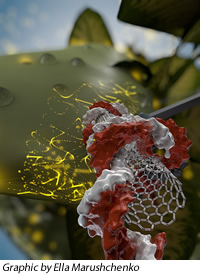
UC Berkeley Physicist Reports a New High Precision Method for Genetic Engineering and Gene Editing
March 20, 2019| |
 Scientists from the University of California, Berkeley reported a new technique that uses carbon nanotubes to genetically engineer any plant, including gene editing with CRISPR-Cas9, in a simple and speedy method similar to a sewing with a needle and thread. The results are published in Nature Nanotechnology.
Scientists from the University of California, Berkeley reported a new technique that uses carbon nanotubes to genetically engineer any plant, including gene editing with CRISPR-Cas9, in a simple and speedy method similar to a sewing with a needle and thread. The results are published in Nature Nanotechnology.
Physicist Markita Landry grafted the gene of interest onto a carbon nanotube which works like a needle diffusing into plant cells, where the gene is expressed as if it was the cell's own gene. The nanotube is very small (1 nanometer in diameter and several hundred nanometers long), thus it easily slips through the tough cell wall of plants.
Genetic engineering methods usually introduce genes through a gene gun or bacteria. Both have the small chance of getting the job done. Nanotubes, however, are highly successful in delivering a gene into the nucleus and chloroplast. Another advantage of the new method is its capability to protect the DNA from being degraded by the cell, and its ability to prevent it from being inserted into the plant's genome. Thus, the technique allows gene modifications or deletions that in the United States and countries other than the European Union would not trigger the designation "genetically modified".
One of the key uses of this new method is in gene editing, particularly in the delivery of Cas9, which is responsible for targeting and cutting the DNA, along with the DNA encoding guide RNA to edit particular genes accurately.
Read more from the University of California, Berkeley and Nature Nanotechnology.
| |
Biotech Updates is a weekly newsletter of ISAAA, a not-for-profit organization. It is distributed for free to over 22,000 subscribers worldwide to inform them about the key developments in biosciences, especially in biotechnology. Your support will help us in our mission to feed the world with knowledge. You can help by donating as little as $10.
-
See more articles:
-
News from Around the World
- Production of Transgenic Plants Increased as Expected, Study Shows
- Genome Editing Offers Great Prospects for South Africa
- Strong Sales Figures Indicate Demand for GM Non-browning Apple
- Australian OGTR Invites Comments on GM Chickpea Field Trial
- USDA FAS-GAIN Evaluates China's 2018 Ag-biotech Industry
- Global Team of Experts Reinventing Sugarcane for More Applications
- Scientists Release Most Complete Genome Assemblies of Cotton
- Experts in Japan Conclude Gene-Edited Foods are Safe
- Biologists Explain Genetic Origins of Saffron Crocus
-
Research Highlights
- Nicotiana benthamiana as Suitable System for Expression of Cotton Boll Weevil α-amylase Inhibitor
- Soybean Cotyledon Used as Platform for Production of Therapeutic Proteins
-
Beyond Crop Biotech
- Modern Beer Yeast Emerged from Mix of European Grape Wine, Asian Rice Wine Yeast
-
Resources
- GMO Fun Facts: What is GMO in Full?
-
Plant
- UC Berkeley Physicist Reports a New High Precision Method for Genetic Engineering and Gene Editing
- Scientists Discover One-Step Genome Editing Technique that Accelerates Seed Breeding
-
Read the latest: - Biotech Updates (December 17, 2025)
- Gene Editing Supplement (December 17, 2025)
- Gene Drive Supplement (February 22, 2023)
-
Subscribe to BU: - Share
- Tweet
